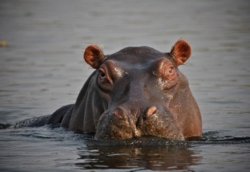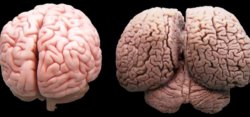In this talk to students at Franklin & Marshall College in November 2017, Dr. Lori Marino talks about whales and dolphins: “who” they are, their history as a species, and their intelligence and cognitive powers. Some things, for example, that you may not have known:
- The ancestors of whales, dolphins and porpoises (known overall as cetaceans) were land animals, known to scientists as archaeocetes, who went aquatic about 50 million years ago.


- The earliest archaeocete found, called Pakicetus, looked a bit like a dog, but was a hoofed animal. The closest living relative of modern cetaceans is the hippopotamus, another hoofed creature.
- Cetaceans haven’t changed very much in the past 15 million years. (We humans, by comparison, have only been around as a species for about 200,000 years and even our hominid ancestors go back only about 5-6 million years)
- Cetaceans are ridiculously smart and highly social. The brains of orcas are 2.5 times the size that’s typical for an animal of their size. And bottlenose dolphin brains are over four times the expected size.

Human brain (left) and orca brain. The cortex is basically a sheet, so the more actual surface area there is, the more cortical tissue can fit in the skull.
- The adult orca brain is the most convoluted brain on earth, and the orca forebrain comprises a greater proportion of the total brain volume than does the human forebrain. The neocortex is greatly expanded, particularly in areas of “integrative” higher-order processing of emotions and social cognition.
- Orcas can dive to depths of over 650 feet when foraging, and belugas can dive to 2,300 feet. A beluga pod (extended family) can travel up to 70 miles a day, and an orca pod more than 100 miles.
- Every pod is shaped by complex cultural traditions that include different dialects, ways of hunting and foraging, and social behaviors.
- Belugas are known as “canaries of the ocean” because of their remarkable ability to imitate sounds and behaviors. They have especially strong family bonds and babysit each other’s calves.
Dr. Marino then talks about how the life of a whale or dolphin in a concrete tank at a marine park or aquarium bears no relation to life in the ocean. Just for starters, an orca at SeaWorld would have to swim the circumference of the main pool 1,400 times to go the daily distance of her cousins in the wild.
Beyond that, they have no stimulation or challenges, and because they’re frequently moved from one park to another, their families are broken up, their social groups are artificial, and sometimes they live in complete solitude, which must be emotionally devastating.
Dr. Marino talks about the Whale Sanctuary Project and our aim to have the first sanctuary completed by the end of 2019.
And the question-and-answer period opens up some fascinating topics. For example, since orcas are often seen deliberately injuring themselves in their tanks, could this mean that they’re trying to end their own lives? And if so, what does this tell us about their level of metacognition – i.e. their ability to reflect upon their own lives?
2 Comments
It is my belief that no mammals should be held in captivity. It is detrimental to any animal. Even ants and bees try to get back to their respective colonies. This especially so for more intelligent animals such as the orca. I think humans, other than marine biologists should stay clear of these animals and let them be. Period.
P.s. I’ve always wondered if the fin droop is like the tail droop in dogs. Loss of dominance and/or independent drive?
Thank you for this forum and a chance to be “heard”.
I absolutely agree with you about the stimulation and not having that outlet. Take for instance a child with Autism if they are not stimulated in someway they remain dormant. So the same would go th
for whales. They are used to swimming and hunting in their pods and without this aggression unfolds. Hence the attacks.